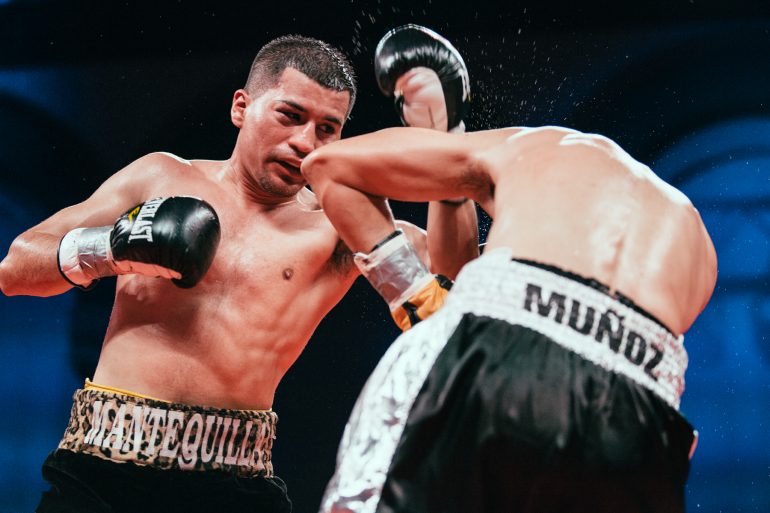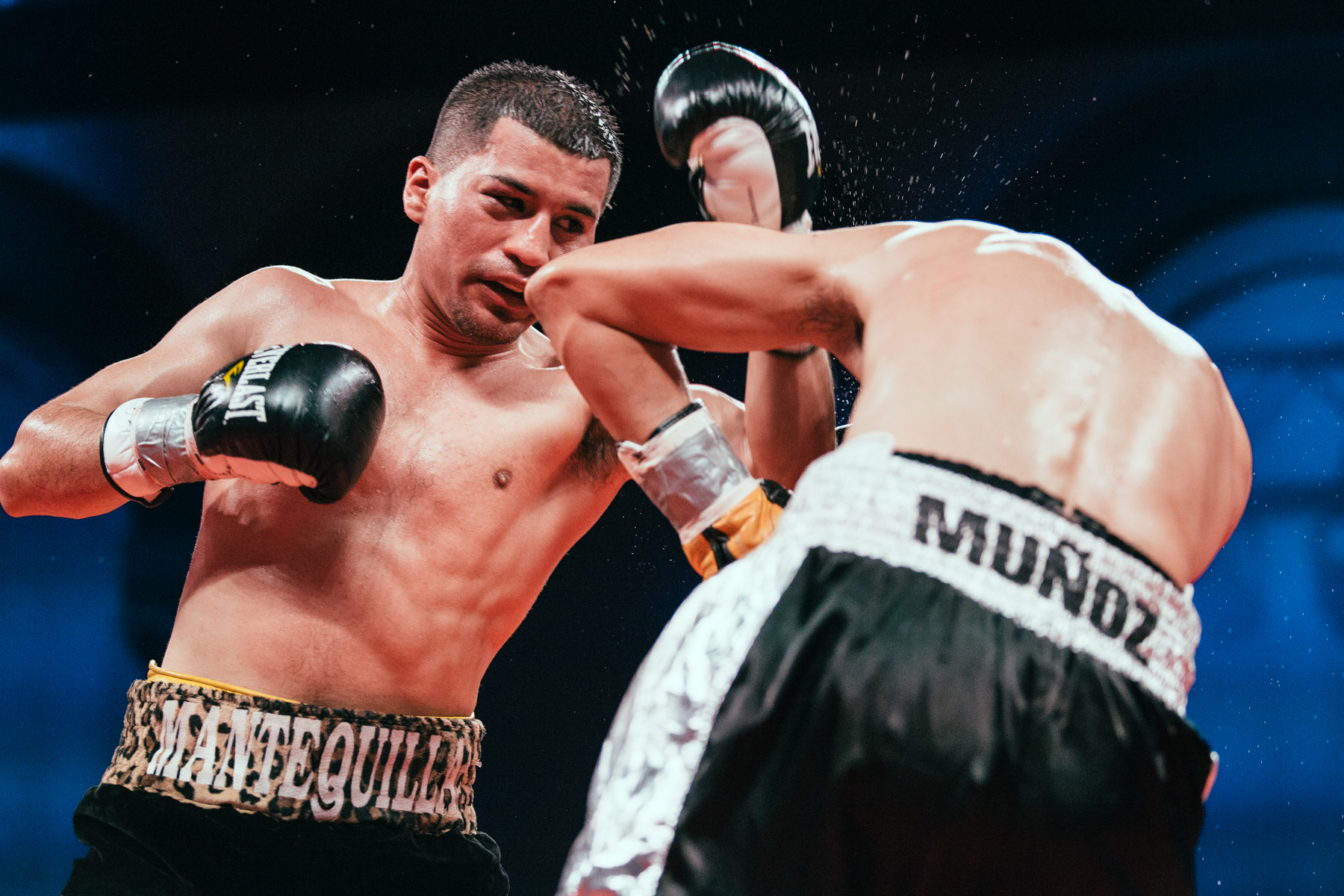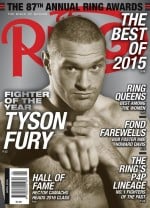The Travelin’ Man goes to Boardwalk Hall: Part two


Junior featherweight Adam Lopez (left) fires an uppercut at Mario Munoz on Feb. 19, 2016. Photo credit: Rosie Cohe/Showtime
Please click here for Part One
Friday, Feb. 19 (continued): At three hours, nine minutes, this “ShoBox” quadruple-header was the second longest show of the series in terms of time that I’ve yet worked (the 200th episode, which ran 10 minutes longer, thanks largely to a three-minute power outage just before the main event and a four-and-a-half minute delay to replace a torn glove in round four of that bout, holds the all-time record for that franchise). Fittingly, this episode took place in Atlantic City (from which the first episode of ShoBox emanated) and though the bouts took place at Boardwalk Hall’s Adrian Phillips Ballroom the crew stayed at Bally’s, the site of the first ShoBox episode.
Only in retrospect did I discover that other similarities existed between the 200th ShoBox (held in Verona, N.Y. on Aug. 5, 2014) and this show:
* In both shows, 33 of the maximum 34 rounds were fought and the lone knockout occurred in one of the three eight-round bouts, not the 10-round main event.
* Two fighters appeared on both cards, if not on the two telecasts. In Verona, Jerry Odom met Vilier Quinonez on the televised portion while Lavisas Williams fought Samuel Teah before Showtime’s cameras began rolling, while, in Atlantic City, both made air as Odom fought Ronald Ellis while Williams met O’Shanique Foster.
* One fighter on the card got to keep his undefeated record (the 18-0 Cecil McCalla over Oscar Godoy in Verona; the 14-0 Adam Lopez over Mario Munoz in Atlantic City), while two other fighters lost theirs (the 11-0-1 Wanzell Ellison lost on points to Tony Luis and the 8-0 Quinonez lost to the 11-0 Odom in Verona while the 16-0-1 Munoz lost to Lopez and the 8-0-1 Williams dropped a decision to Foster).
* Finally, at least one fight ended in a draw. In Verona, Antoine Douglas’ undefeated record (14-0) became an unbeaten one after drawing with Michel Soro in the main event while in Atlantic City John Magda’s 11-0 ledger and Ronald Ellis’ 12-0 slate suffered similar fates after drawing with Christopher Brooker and Odom respectively.
Not all draws are created equal, however. The Magda-Brooker verdict was heavily criticized because virtually everyone in the arena thought Brooker’s smothering pressure and far more hurtful blows established concrete dominance. The CompuBox numbers confirmed that impression as Brooker out-threw (481-268 overall, 101-71 jabs, 380-197 power) and out-landed (152-78 overall, 91-8 jabs, 133-70 power) Magda in all three phases. Brooker also demonstrated better ring generalship by limiting the taller Magda to just 8.9 jab attempts and one jab connect per round while the brawling Brooker fired 47.5 power punch attempts and landed 16.6 power shots per round, well above the super middleweight norms of 30 and 11.3 respectively. In the final three rounds Brooker out-landed Magda 57-17 overall and 50-15 power, a finishing kick that left Magda battered and relieved just to make it to the final bell. Even Magda recognized Brooker’s superiority immediately after the fight ended, for he raised his opponent’s arm before returning to his corner.
Though Magda failed to dodge enough of Brooker’s blows, two of the judges allowed him to dodge his first defeat. While Lawrence Layton’s 78-74 score for Brooker was closest to reality, he was trumped by Donald Givens’ 76-76 submission, as well as the outrageous 77-74 scorecard for Magda produced by James Kinney. As analyst Steve Farhood pointed out on the telecast, Givens was one of the three judges suspended in the wake of Erislandy Lara’s majority decision loss to Paul Williams in July 2011 (he scored it 116-114 for “The Punisher”) and this was just the third card he has worked since then. This scorecard won’t help rebuild confidence in his ability.
Kinney, according to BoxRec, is a new face on the judging scene as it lists him as logging 21 fights before this card, his first higher-profile show and his fourth slate of bouts overall. Layton, on the other hand, was the veteran of the group as he has worked steadily for 20 years and has judged nine title fights since 2003, including Sergey Kovalev-Bernard Hopkins in 2014 and Krzysztof Glowacki-Marco Huck last year. His scores in those fights (120-106 Kovalev and 96-93 Huck) were in line with his compatriots. Here, his pedigree was on display.
(Editor’s Note: The draw verdict was changed to a majority decision win for Brooker after an error in Kinney’s scorecard was discovered by the New Jersey State Athletic Commission. Kinney scored the bout 77-74 for Brooker instead of 77-74 Magda. Groves’ comment: “Kinney’s corrected scorecard was much more in line with what happened inside the ring than the score that was originally cited. Therefore, instead of scorn Kinney deserves credit for a job well done.”)
The other draw on the show, Ellis-Odom, was far less onerous. The same panel of judges handled that contest and, in my view, performed better as Kinney and Layton saw it 76-76 while Givens saw Ellis a resounding 77-74 winner (an aside: ring announcer Thomas Treiber deserves kudos for the way he rendered the usually-difficult-to-deliver majority draw verdict – the lone winning score first and then the two draw scores in a way that maintained the suspense until the final second). Statistically speaking, Ellis earned connect leads of 154-131 overall, 40-22 jabs and 114-109 power mostly because he threw so many more punches (76.3 per round to Odom’s 58.8). The round-by-round breakdowns showed Ellis out-landed Odom overall in six of the eight rounds but except for his huge third round (36-14 overall), the margins were four or fewer connects. Also, the percentage gaps were relatively small (Odom led 28%-25% overall and 18%-14% jabs while Ellis prevailed 34%-31% power) and there was little to choose between Ellis’ flashier combinations and Odom’s stronger blows. To me, this result shouldn’t damage either man’s career; in fact, I believe it should earn them another ShoBox appearance – perhaps against each other.
Yet another link between the two cards was that each featured a redemptive tale. In July 2014, Tony Luis, who was coming off a deceptively lopsided loss to Ivan Redkach on Showtime’s air six months earlier, sprung the mild upset over Ellis while, here, Foster regained traction against the unbeaten Lavisas Williams following a puzzling decision loss against Samuel Teah last November.
The decorated amateur was favored to turn back Teah but, for whatever reason, Foster, who was making his national TV debut, couldn’t pull the trigger as he averaged a meager 31 punches per round to Teah’s 58.9. Worse yet, Teah averaged a sky-high 7.9 landed jabs per round against Foster, who was out-landed 128-91 overall, 63-32 jabs and 65-59 power. Not much was known about Williams going in – no footage of any recent fights was available to research – but one salient fact was known: Their only common opponent was Teah and while Foster lost, Williams beat Teah by four-round majority decision.
Once the opening bell sounded, however, Foster showed off the skills that helped him win eight national titles and delivered him to the doorstep of making the 2012 US Olympic team. The taller Williams tried to keep Foster at bay with a busy jab but Foster took his time, picked his spots and inflicted heavier damage with each connect. Foster floored Williams in rounds two, three and four before closing the show with a final knockdown early in the seventh, capping a performance that saw him out-land the bloodied Williams 94-46 overall and 67-26 power and pile up emphatic accuracy gaps (38%-13% overall, 29%-9% jabs, 44%-21% power). With this performance, Foster managed to reverse the narrative painted in the Teah bout – that his skills would freeze under the hot TV lights – and replaced it with a strong foundation that could lead to future opportunities.
The main event between Lopez and Munoz featured a pleasing stylistic blend as the shorter Lopez used agility, speed and timing to counteract Munoz’s relentless aggression. The pace was hot throughout (Lopez averaged 60.2 punches per round to Munoz’s 78) and, while Munoz succeeded in forcing Lopez to exchange (70.5% of their combined punches and 90.3% of their connects were power shots), Lopez’s precision (37%-24% overall, 16%-6% jabs, 43%-33% power) led to small but significant connect gaps (220-184 overall, 22-17 jabs, 198-167 power), most of which were achieved in the first four rounds (80-62 overall, 70-57 power) and in the last two (63-45 overall, 58-41 power). As I told a couple of ringside press members after the show, Lopez’s technique proved that he’s driven these roads before and I look forward to seeing him get behind the proverbial wheel again.
*
With the show finally over and my equipment packed, I headed toward the production truck for a quick bite. Along the way, however, I ran into Rachel Charles, who, on this night, was a member of Team Ellis. Her joyful reaction to seeing me confirmed a trait I had long known about Rachel: Win, lose or draw, her enthusiasm for boxing, and for life in general, knows few bounds. She asked her friend to snap a photo of us for her extraordinarily active Facebook page, an image which was already posted by the time I returned to the room. She also posted a close-up of Ellis’ right hand, which had swollen to elephantine proportions.
With 2 a.m. fast approaching, I knew the clock was working against me. I still had some CompuBox business to finish and it usually takes me a while to wind down from working a live show, even one this lengthy. I felt I needed to arise at 6:30 a.m. to comfortably navigate the early demands of the travel day and, with the time window so tight, I had to decide whether to stay up and get a jump on my writing or get a little rest first. In years past, I probably would have opted for the former but this older (and hopefully wiser) version chose the latter. After all, I needed to be as alert as possible to make the drive from Atlantic City to Philadelphia. So, shortly before three in the morning, I switched off the lights and hoped for the best.
Saturday, Feb. 20: With a semi-watchful eye on the clock radio, I managed to get in three-and-a-half hours of rest rather than sleep. The truncated slumber cycle left me feeling somewhat flat but my main objective was achieved: I was functional enough to get ready for the day and to start the process of coming home.
Step one was retrieving the rental vehicle. Audio guy Mike Sena, in whose name the vehicle was rented, wisely decided to valet the vehicle to make finding it less complicated for me. However, because I usually self-park, I wasn’t fluent in the routines involved with a valet vehicle. On past trips, I was able to call down to the front desk, read the claim number and have the car waiting for me at the hotel entrance by the time I checked out. Here, it wasn’t that simple; instead of calling down and getting the ball rolling, I was told I had to physically give the claim ticket to the person manning the station, then wait for the vehicle to be driven to the front entrance. I was informed by various employees that, given the time of day, my wait would range between virtually nil and 15 minutes. Of course, my down time after checking out of the hotel ended up being on the long side but I didn’t mind because I had given myself a comfortable time cushion.
With the help of the man to whom I gave the claim ticket, I found my way onto the Atlantic City Expressway with ease. Traffic was light and very manageable and, for the first time ever, I didn’t even think of breaking out the Magellan GPS. With this act, the Philly-to-AC route officially became part of what I call my “sphere of familiarity,” the areas on Earth which I can successfully navigate without electronic aids. Yes, I still had to pay attention to the signage so that I wouldn’t miss any crucial turns but, most of the time, I felt enough at ease to allow my mind to drift toward other matters.
Because rental companies likes to have their cars returned with full gas tanks, I stopped by a plaza situated on the Expressway, got $6 of gas to move the needle a step or two past full, then went on my merry way. Thanks to the vehicle’s “eco-mode,” the needle barely inched downward by the time I arrived at Philadelphia International Airport.
After dropping off my ride, I walked inside the terminal, glanced at the flight monitor and saw something I had never encountered before. At this particular F terminal location, the list of flights is detailed on three separate monitors placed side by side. The left and right monitors looked normal but the middle monitor – the one that had information for my flight – looked anything but normal as a white strip with black texted “computer language” scrolling upward obscured the leftmost two-thirds of the screen from top to bottom. It ended up being a minor nuisance, for a nearby agent at the ticket counter filled in the blanks.
In recent months, I’ve learned that some airports don’t offer full TSA Pre-Check privileges and such was the case for Terminal F passengers in Philadelphia. The round yellow sticker on my boarding pass allowed me to walk under the simple metal detector instead of entering the full-body scanner and I was still allowed to keep my light jacket and shoes on. But for everything else, I had to revert to pre-Pre-Check routines such as unpacking and repacking my two laptops, placing my wallet, keys, change and cell phone inside the laptop bag as well as separating the liquids bag from everything else. It was a logistical challenge but I managed to do everything without inordinately holding up the queue.
I boarded the aircraft and settled into my aisle seat in row 11, which, interestingly, was the same location I occupied two days earlier. The flight left on time (a notable occurrence in Philadelphia) but, thanks to robust crosswinds, the approach into Pittsburgh was quite choppy as well as faster than usual. The wheels struck the runway with atypical force but all was well after that.
I couldn’t have asked for a more beautiful day to drive home as the sky was nearly cloudless and the temperature soared toward 70. The snow that had covered the cars in the parking lot on Thursday was a distant memory and I thoroughly enjoyed the trip home. Because I drive the same route at the same speed, most times, I guessed I would pull into the driveway at 3:45 p.m. For the record, I was actually one minute early.
The wait between trips will be shorter this time, for my next assignment will take me to Bethlehem, Pennsylvania to work the March 5 ShoBox broadcast that will include junior middleweights Julian Williams and Marcello Matano, middleweights Tony Harrison and Fernando Guerrero and a match featuring Antoine Douglas against substitute Avtandil Khurtsidze since Sam Soliman was forced to withdraw due to injury.
Until next time, happy trails!
*
Lee Groves is a boxing writer and historian based in Friendly, W.Va. He is a full member of the BWAA, from which he has won 13 writing awards, including 10 in the last five years and two first-place awards since 2011. He has been an elector for the International Boxing Hall of Fame since 2001 and is also a writer, researcher and punch-counter for CompuBox, Inc. He is the author of “Tales from the Vault: A Celebration of 100 Boxing Closet Classics.” To order, please visit Amazon.com. To contact Groves, use the e-mail [email protected].















